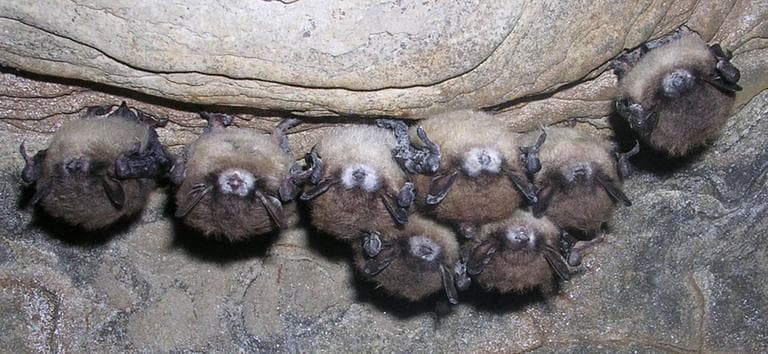Advertisement
Millions Of Bats Dying From Fast-Spreading Disease

Reported by Anya Huneke
PLYMOUTH, Vt. — When you hear the term “bat cave,” you may think of Batman and Robin. But scientists throughout the Northeast think of millions of bats, dying from disease.
Wildlife technician Alyssa Bennett headed into the snowy woods of the small central Vermont town of Plymouth — up a steep hill — toward Plymouth Cave.
"So I’m just looking in the cracks and crevices on the outside here to see if any bats are out here,” Bennett said.
White nose syndrome is the reason for Bennett's trip here. It's a disease that has devastated bat populations in caves across the Northeast and beyond. First detected in 2006 in Albany, N.Y., it has quickly spread — it's now confirmed in 16 states and 4 Canadian provinces.
New figures released by the U.S. Fish and Wildlife Service last month attribute roughly 6 million bat deaths to the disease.
"The numbers are clearly, clearly just at a fraction of what they once were," said Scott Darling, a bat biologist with Vermont Fish and Wildlife who is heading the effort to address white nose syndrome in the Green Mountains.
The biggest challenge initially for scientists was understanding the disease itself. They now know it is caused by a fungus that grows around the nose of bats and, more destructively, on their wings.
“This fungus is called geomyces destructans and is really a very invasive kind of fungus that actually penetrates into the tissue, the skin tissue of the bats and begins to digest internally,” Bennett said.
Advertisement
It does its damage when the animals are most vulnerable: during hibernation, when their immune systems are down.
Bats typically go into a deep winter sleep — their body temperature and heart rate drop, and they live off their own fat reserves. But white nose syndrome causes them to wake up every four to five days, and they set out looking for food and water. Inevitably they find little to none in the dead of winter.
Yet they’re burning energy — through constant grooming as well — as they try to remove the fungus from their wings.
"Bats are really fastidious, so they’d keep themselves very clean normally. Unfortunately, when they’re hibernating, the fungus is taking advantage of that situation,” Bennett said.
The bats end up dying, experts believe, of thirst, starvation or tissue degradation. And they have been dying in jaw-dropping numbers: many bat caves have lost 90 to 100 percent of their population.
Various species of bats have been added to state and federal endangered and threatened species lists.
"Us scientists often comment that it’s perhaps the most precipitous decline in animal species, perhaps since the passenger pigeon."
That was in the early 20th century. Yet getting the public to pay attention has not been easy, in part because it’s hard to predict all the direct and indirect consequences of a massive bat die-off.
What is known is that bats play a significant role in insect management, eating up to half their body weight in bugs each night.
"I like to think of them as a natural pesticide, and that’s really important, especially to the agriculture industry," Bennett said.
"In Vermont, I’ve made estimates that the half million bats we’ve lost would have eaten about 2.5 billion insects per night," Darling said. "What does that mean? I’m not sure, but I usually close those comments with a statement that logic alone kind of dictates that you ought to be concerned when you lose such an influential part of the ecosystem.”
The federal government has launched a national response plan. Meanwhile, treatments are being studied, including biological agents and chemical fungicides. But solutions like that pose risks.
"It’s this delicate ecosystem, and if we wanted to go in there and kill this one fungus off, it would be really likely that we’d disrupt the whole ecosystem," Bennett said. "We probably would kill other things off that (we) don’t want to be killing off.”
Despite the record drop in bat numbers, scientists catch tiny glimmers of hope. A small number of bats do survive winter after winter, making experts wonder if some bats are equipped to beat the disease.
Still, even a best-case scenario leaves bats with a very long road to recovery. With reproduction rates of only about one pup per year, it would take decades — maybe centuries — for them to rebuild their populations.
This program aired on February 16, 2012.